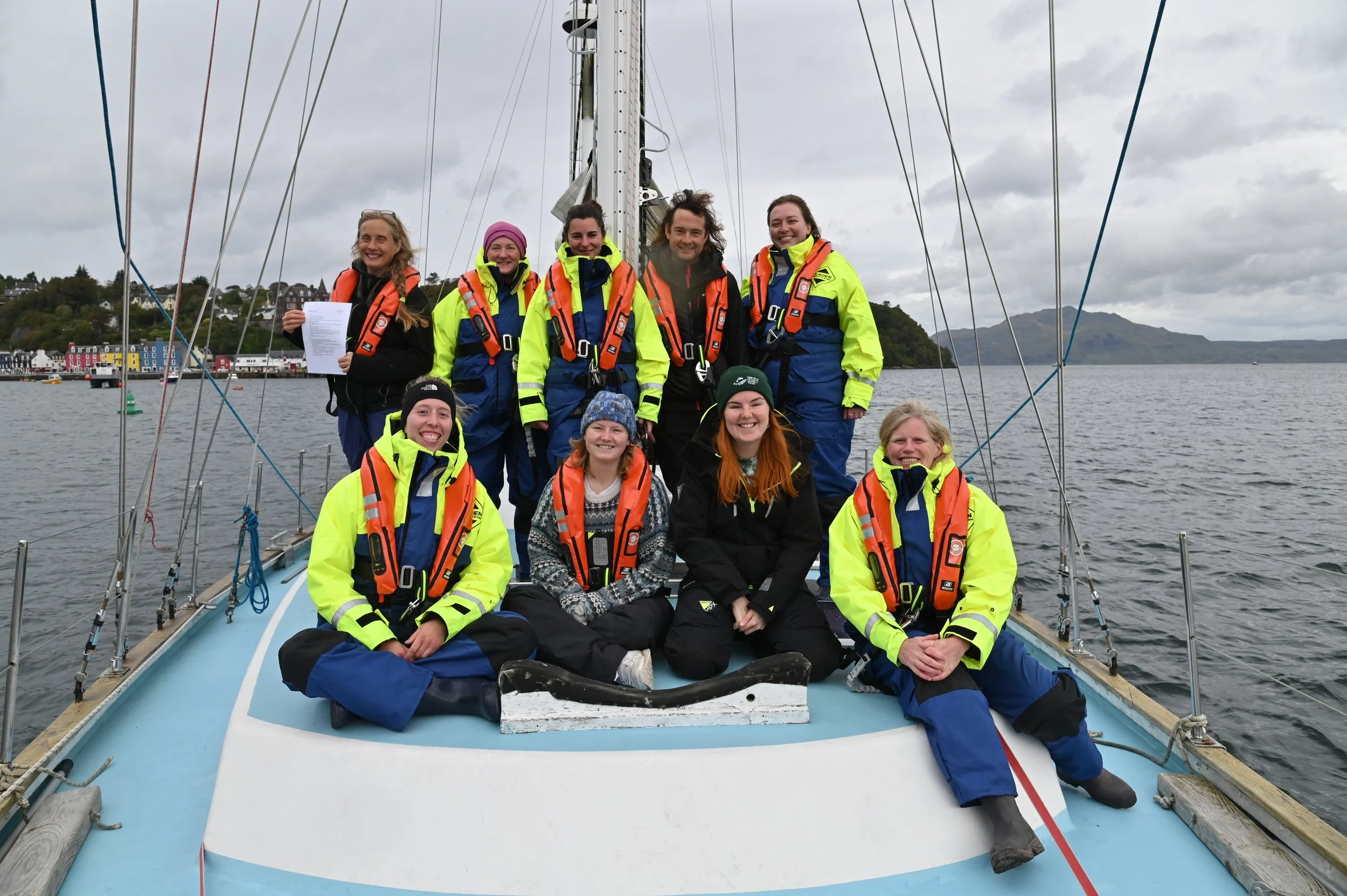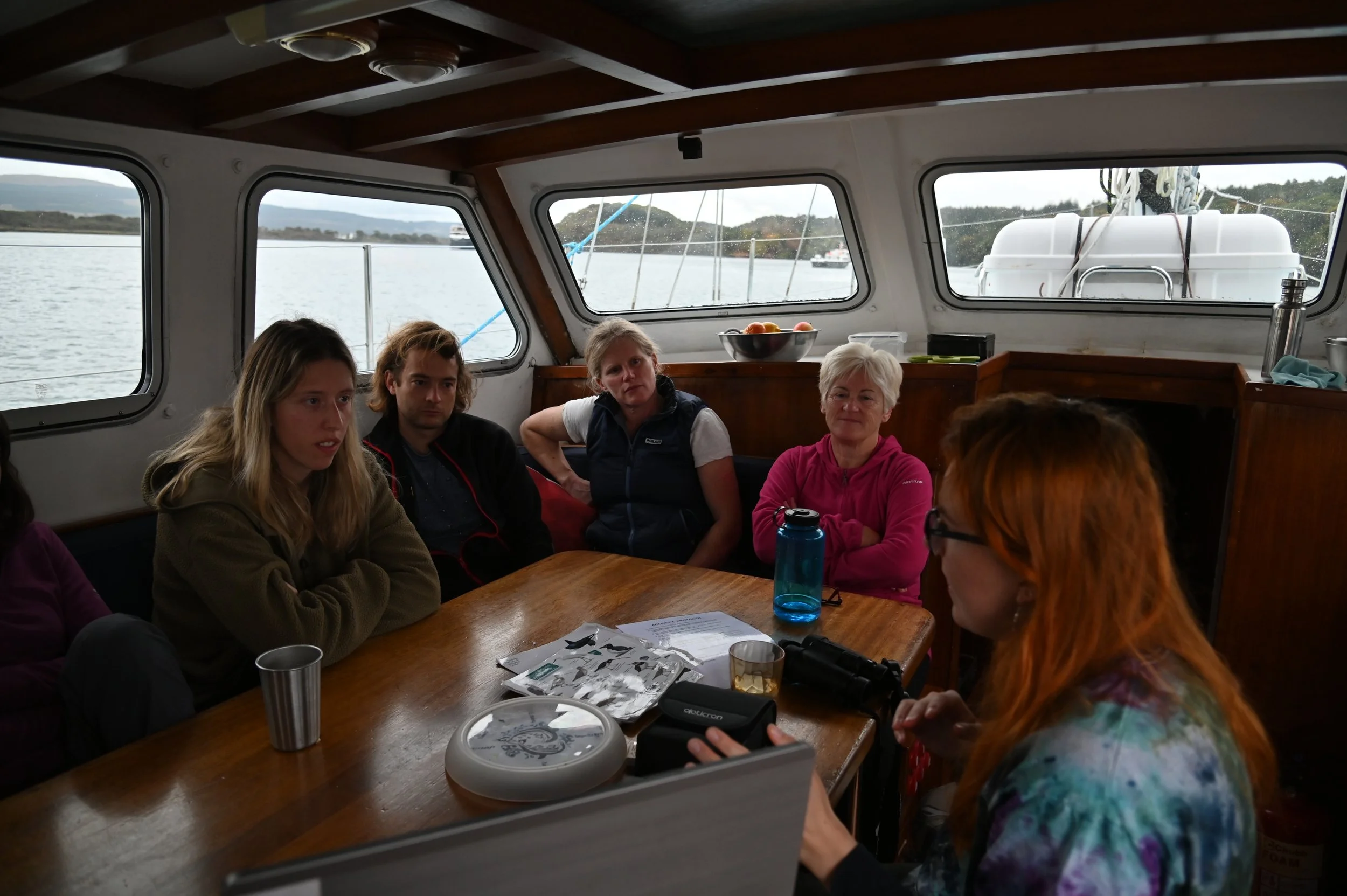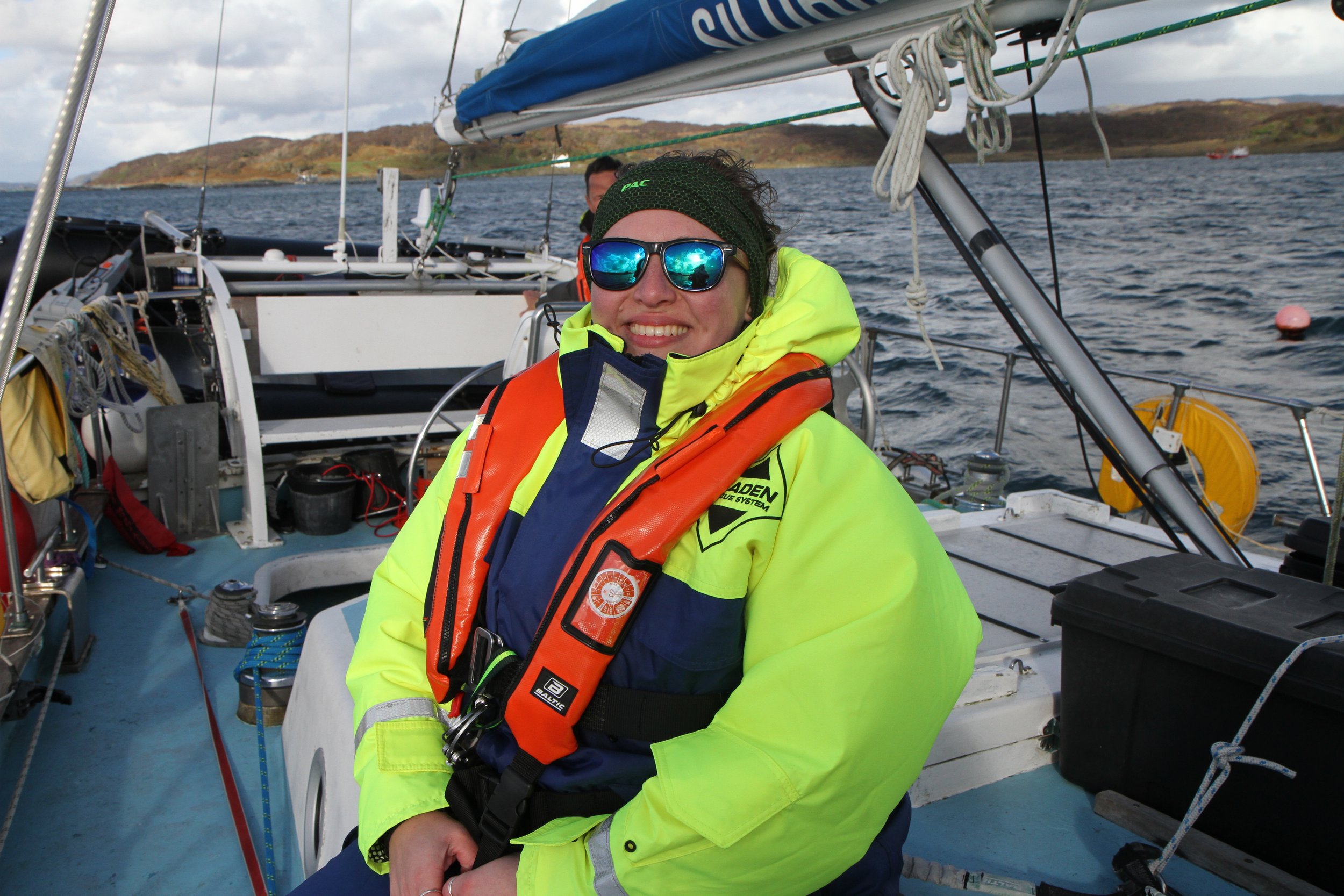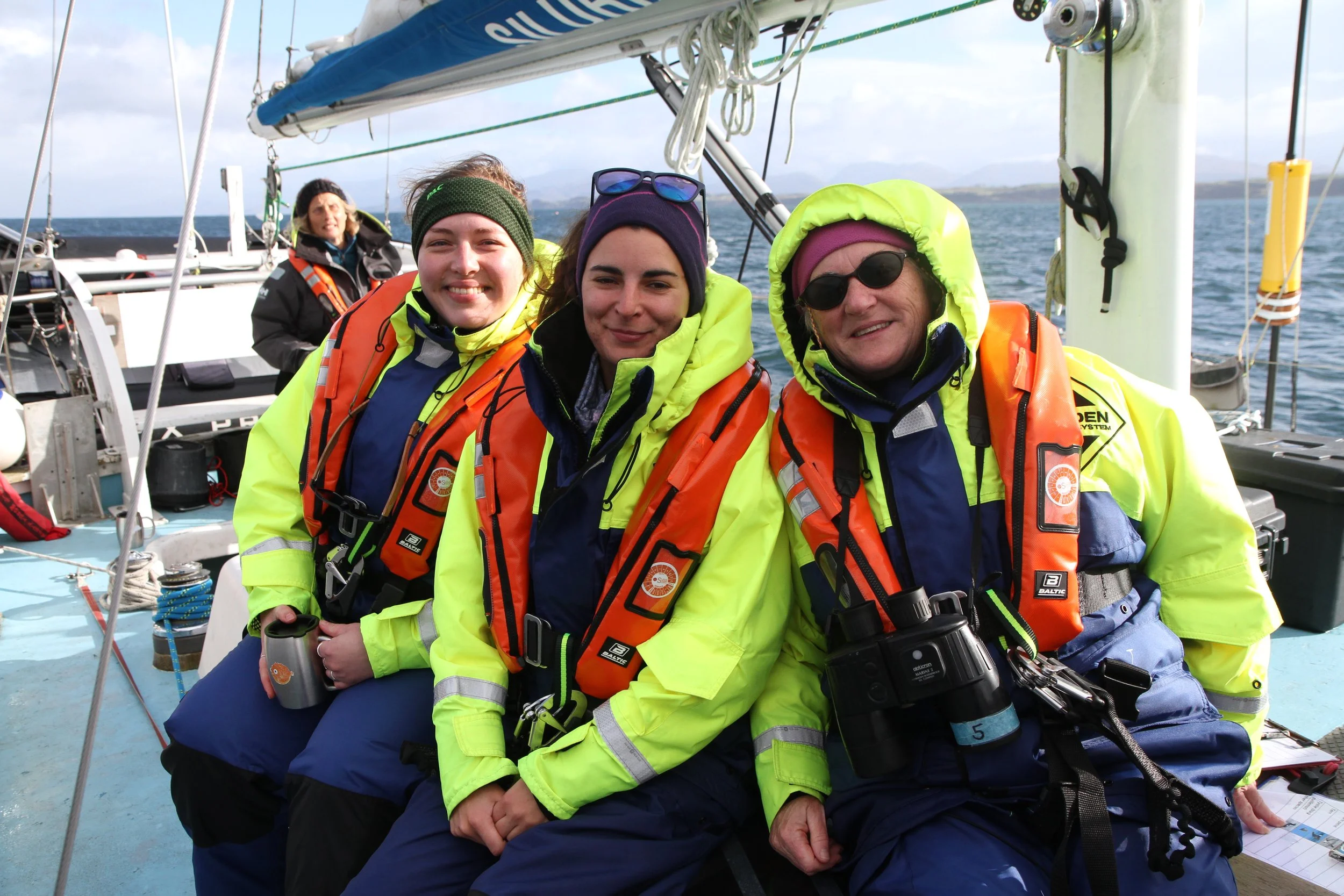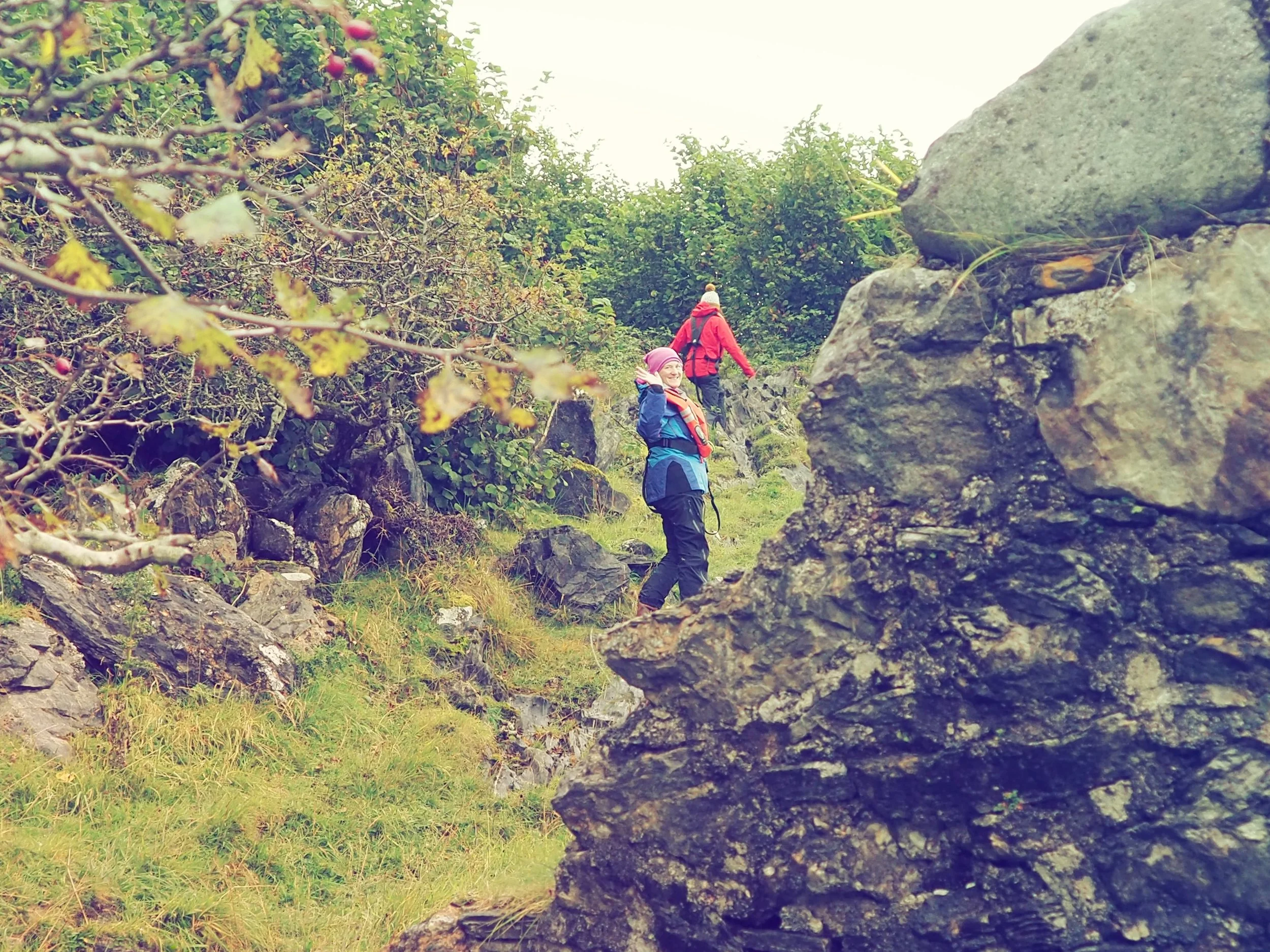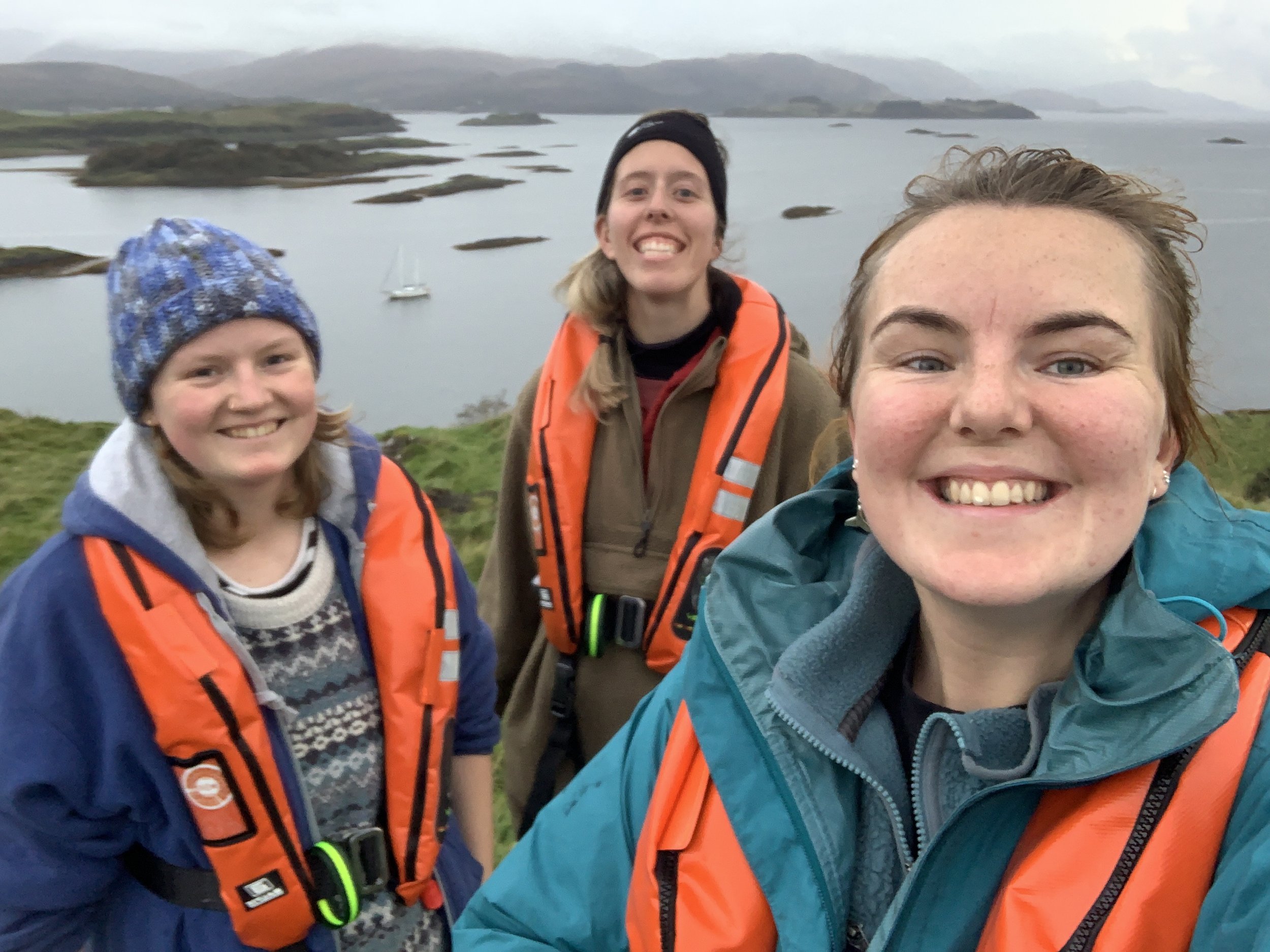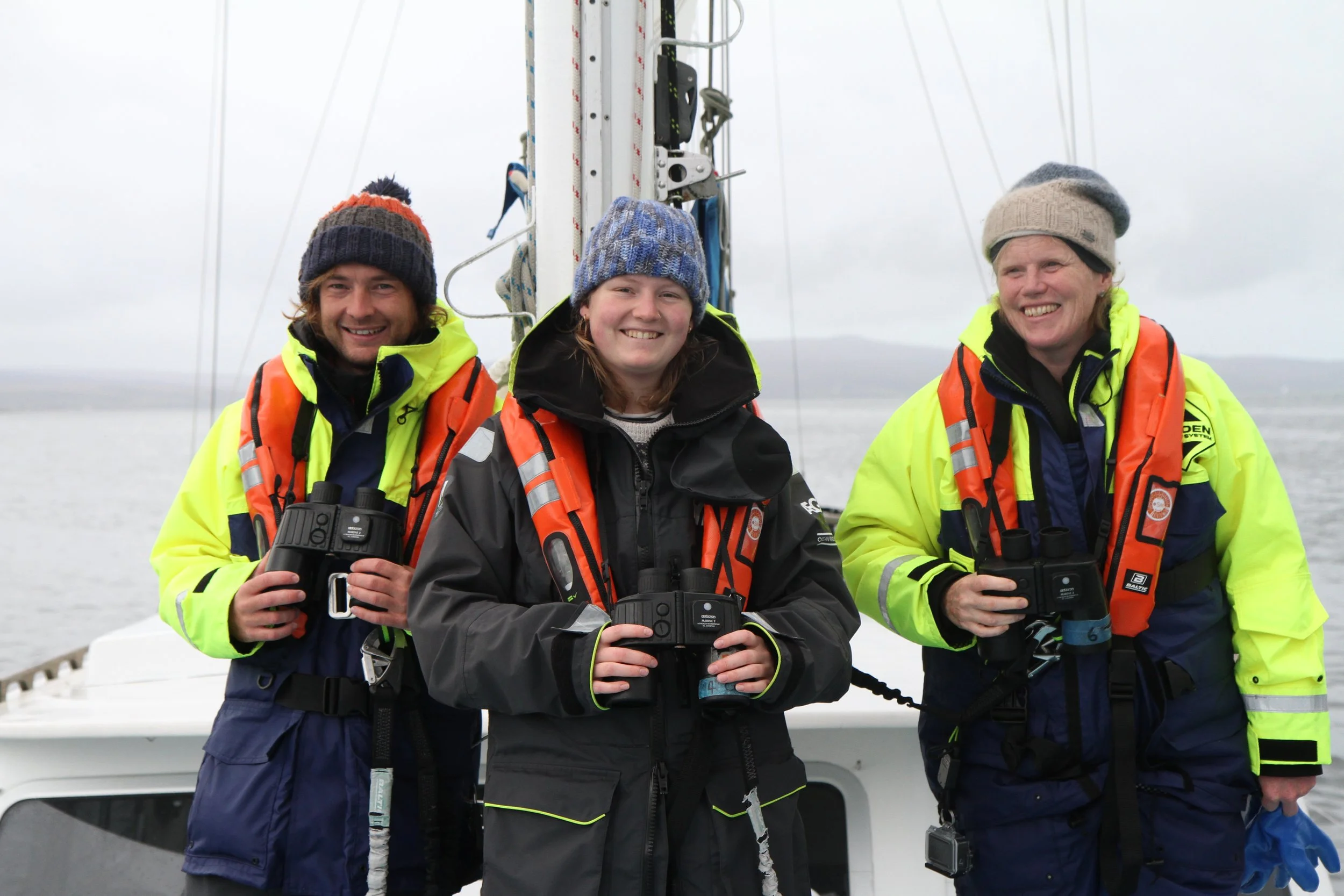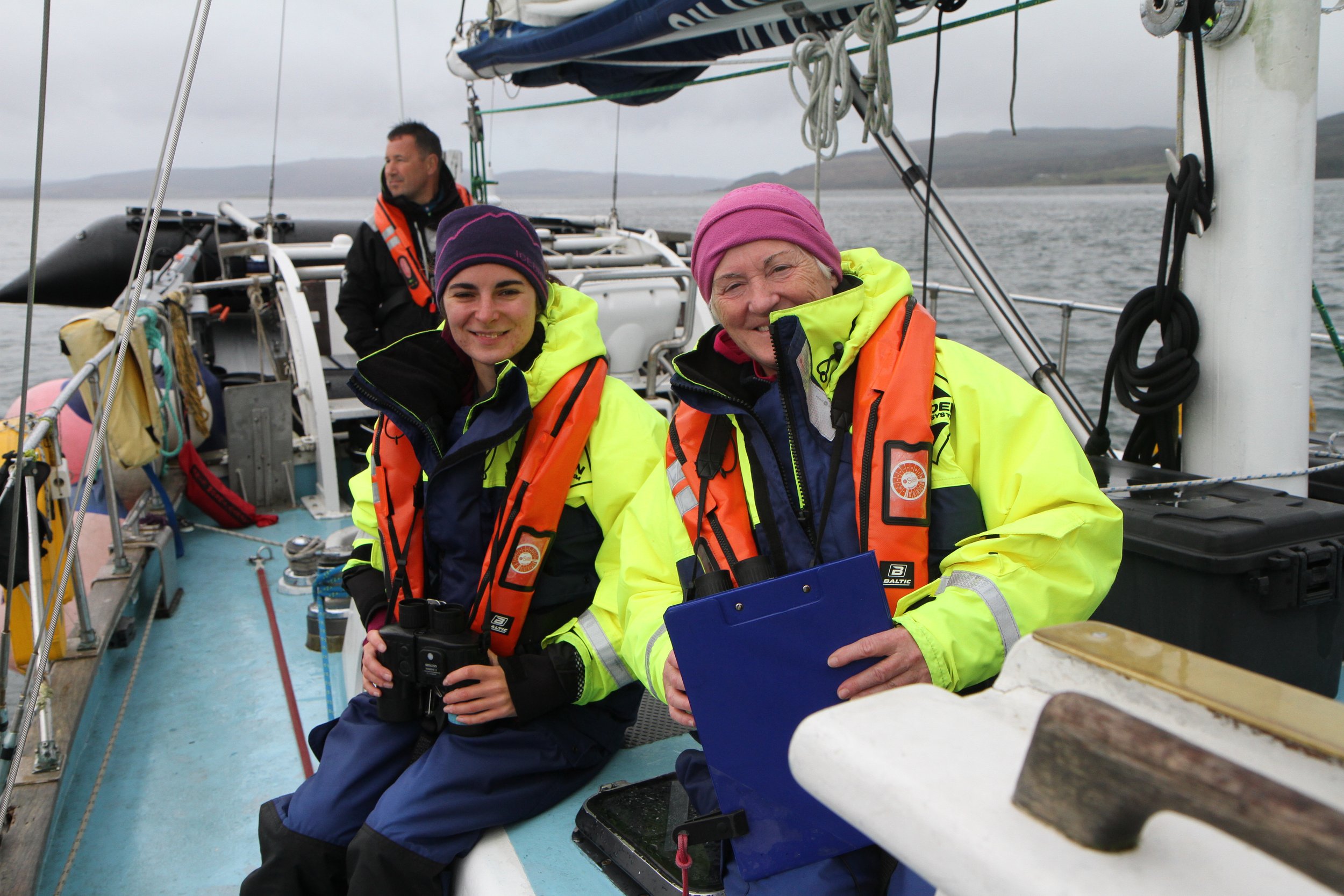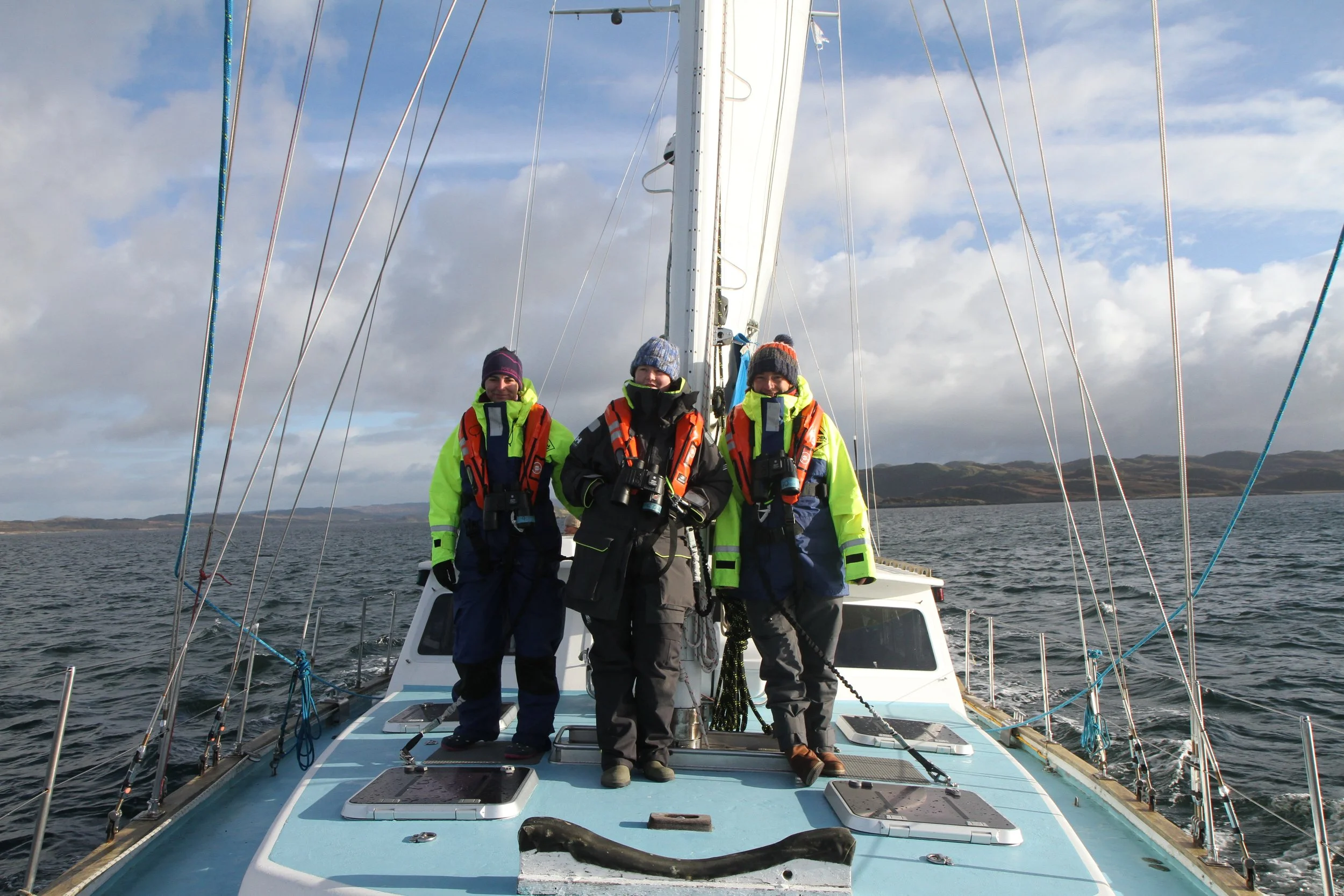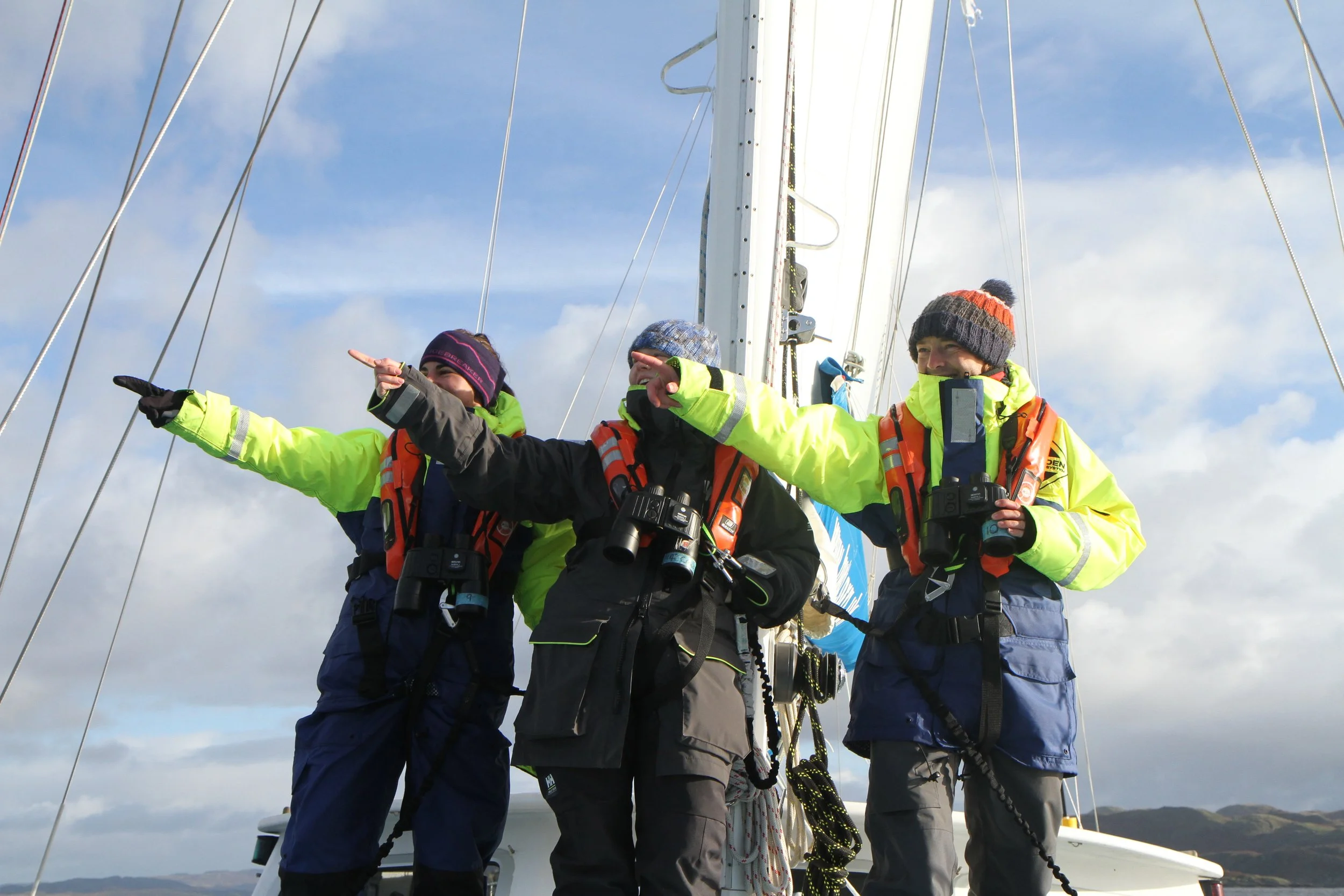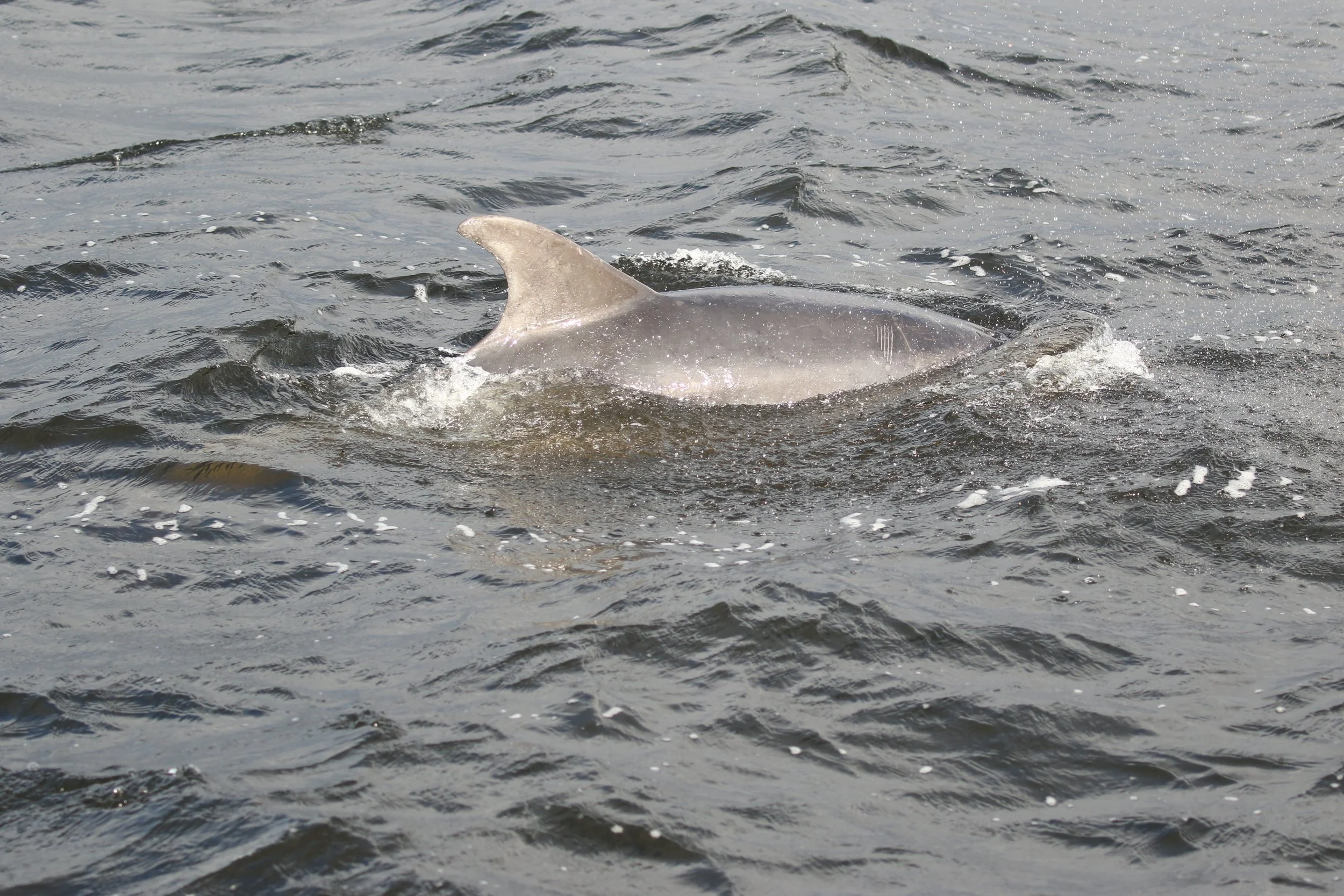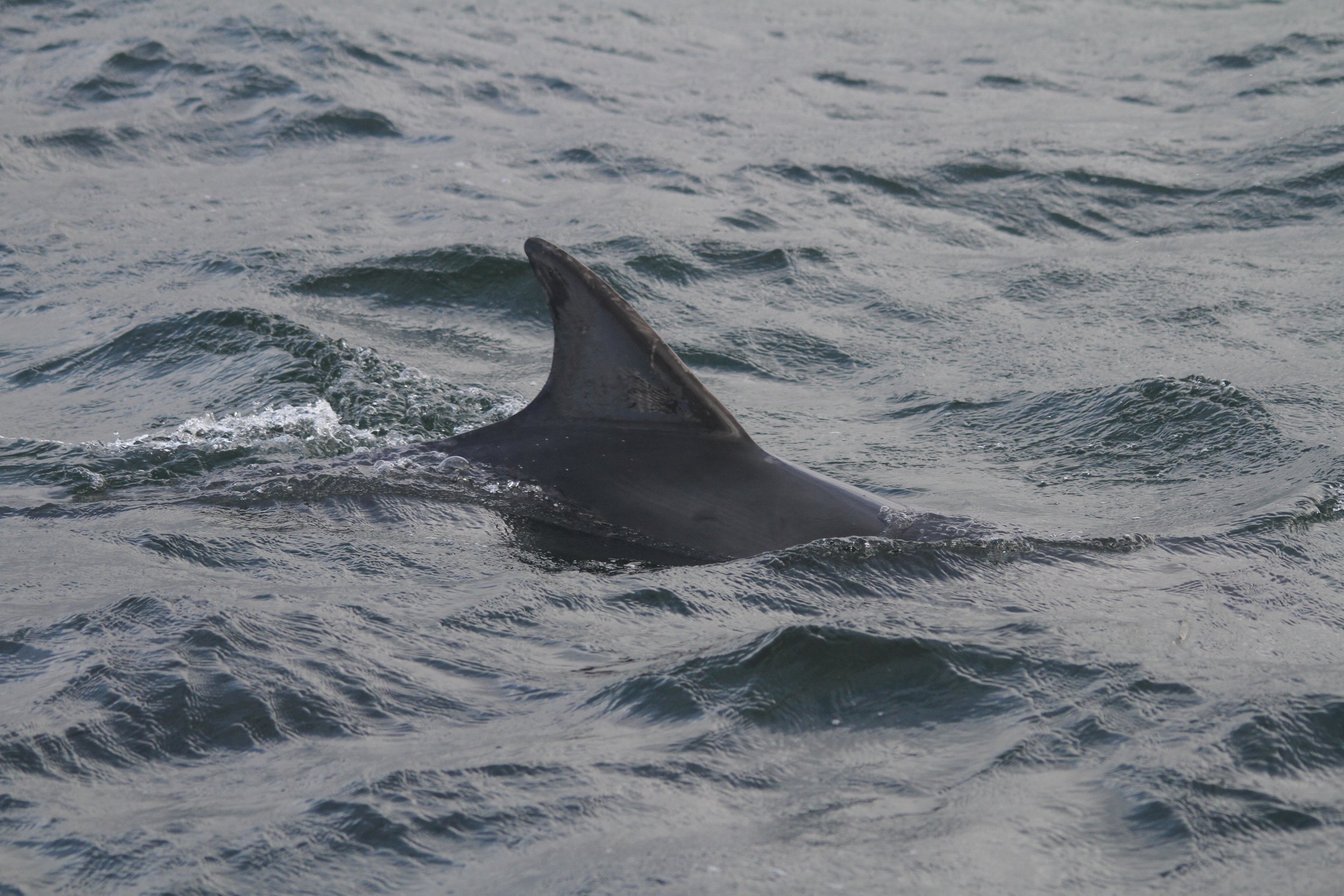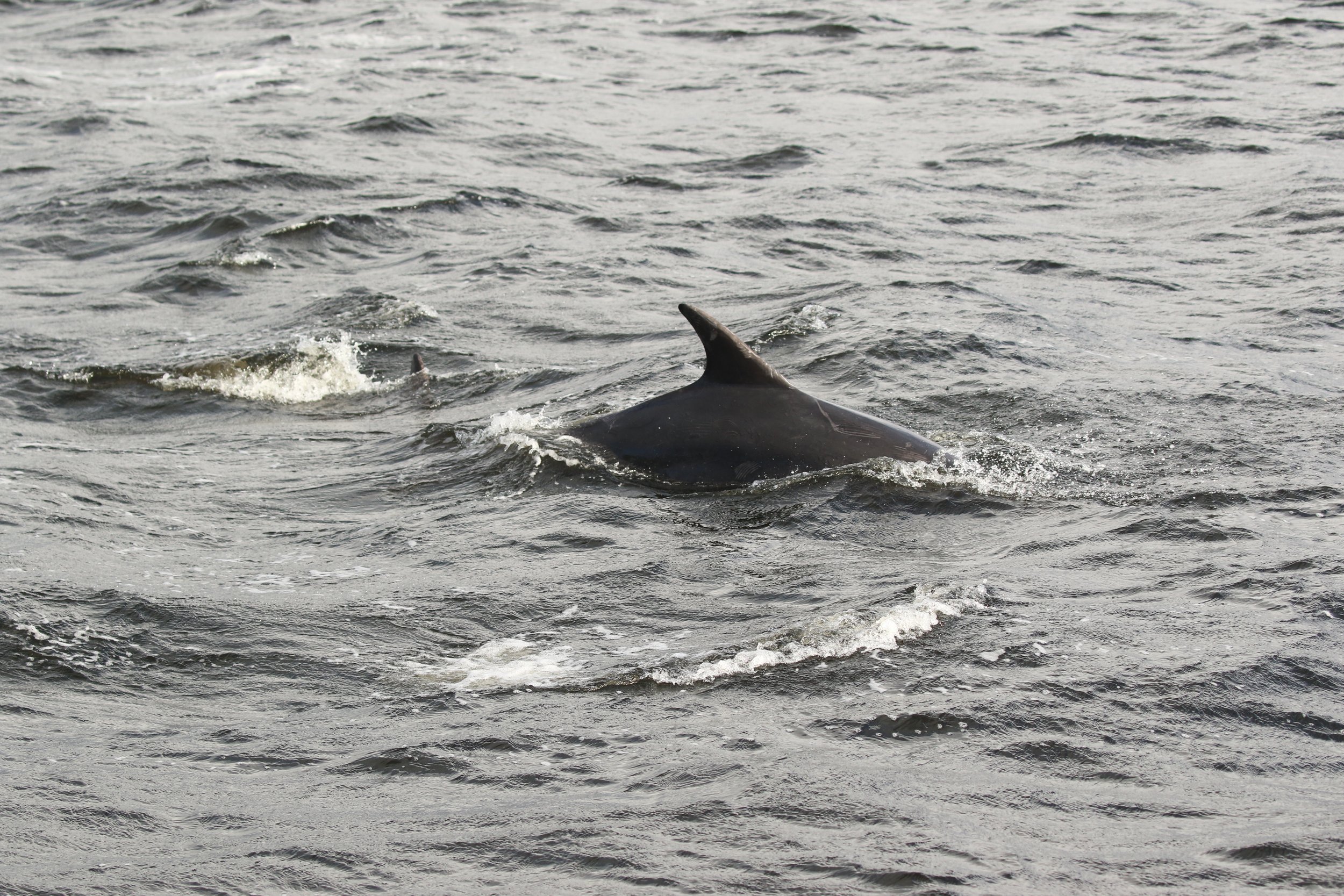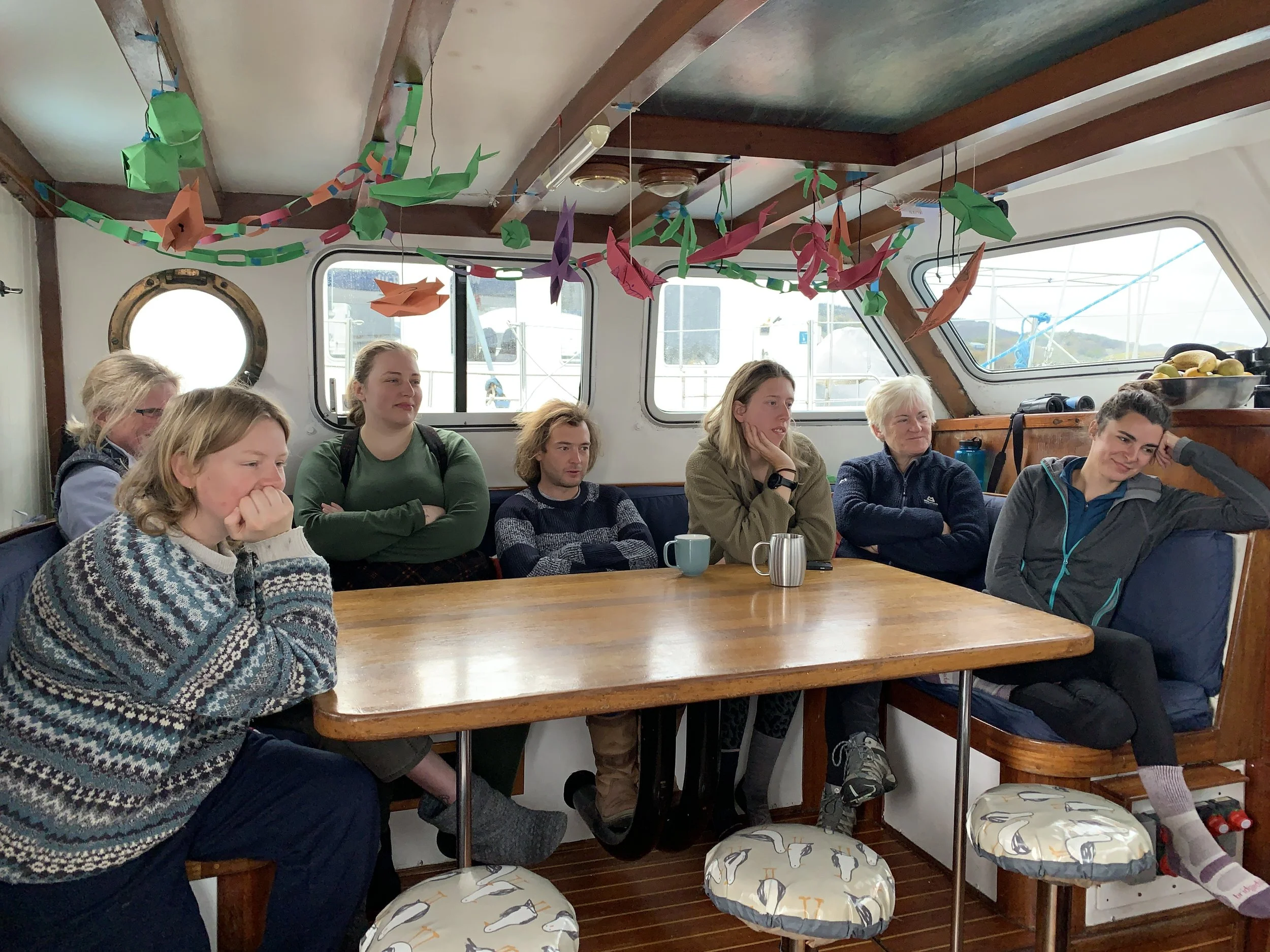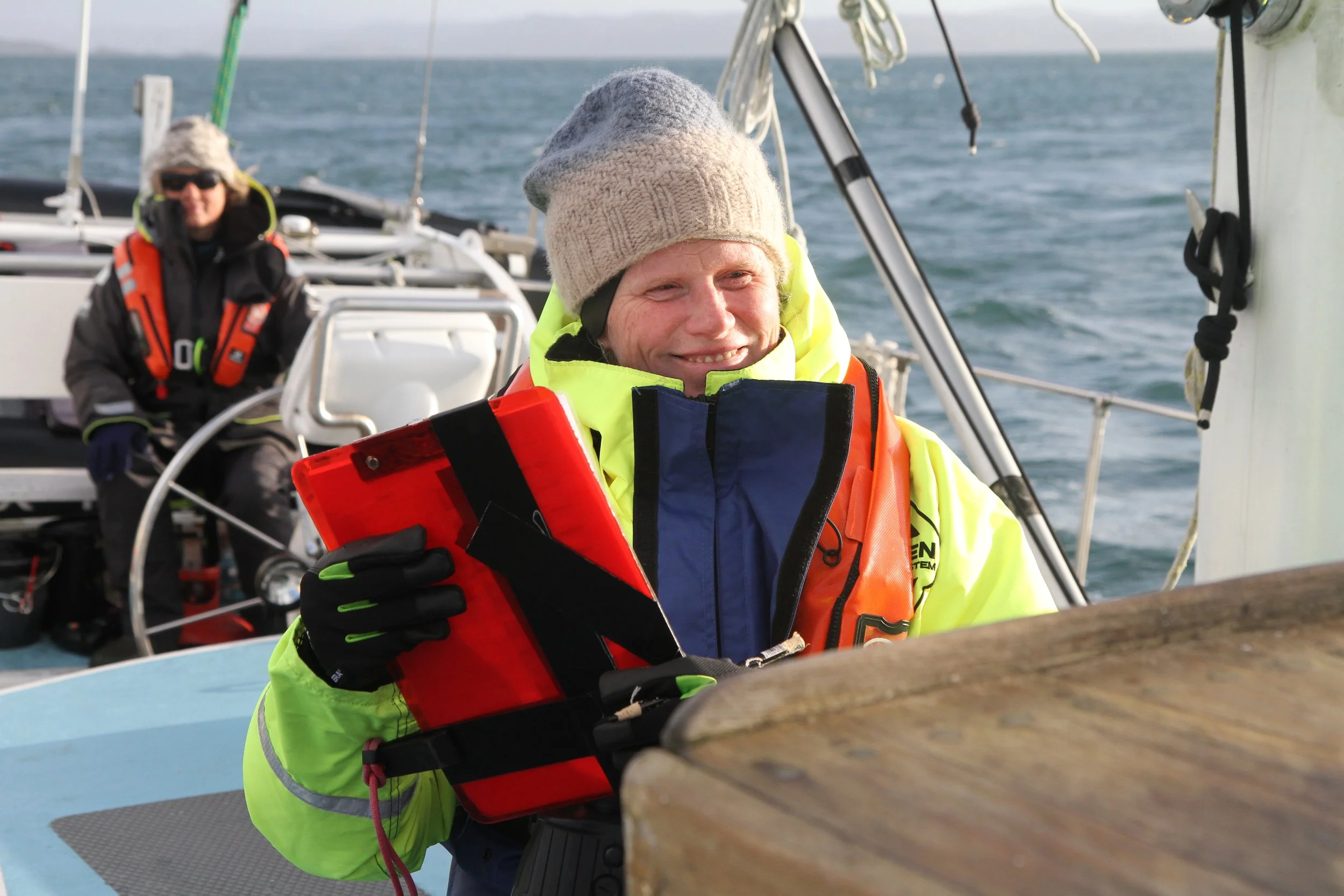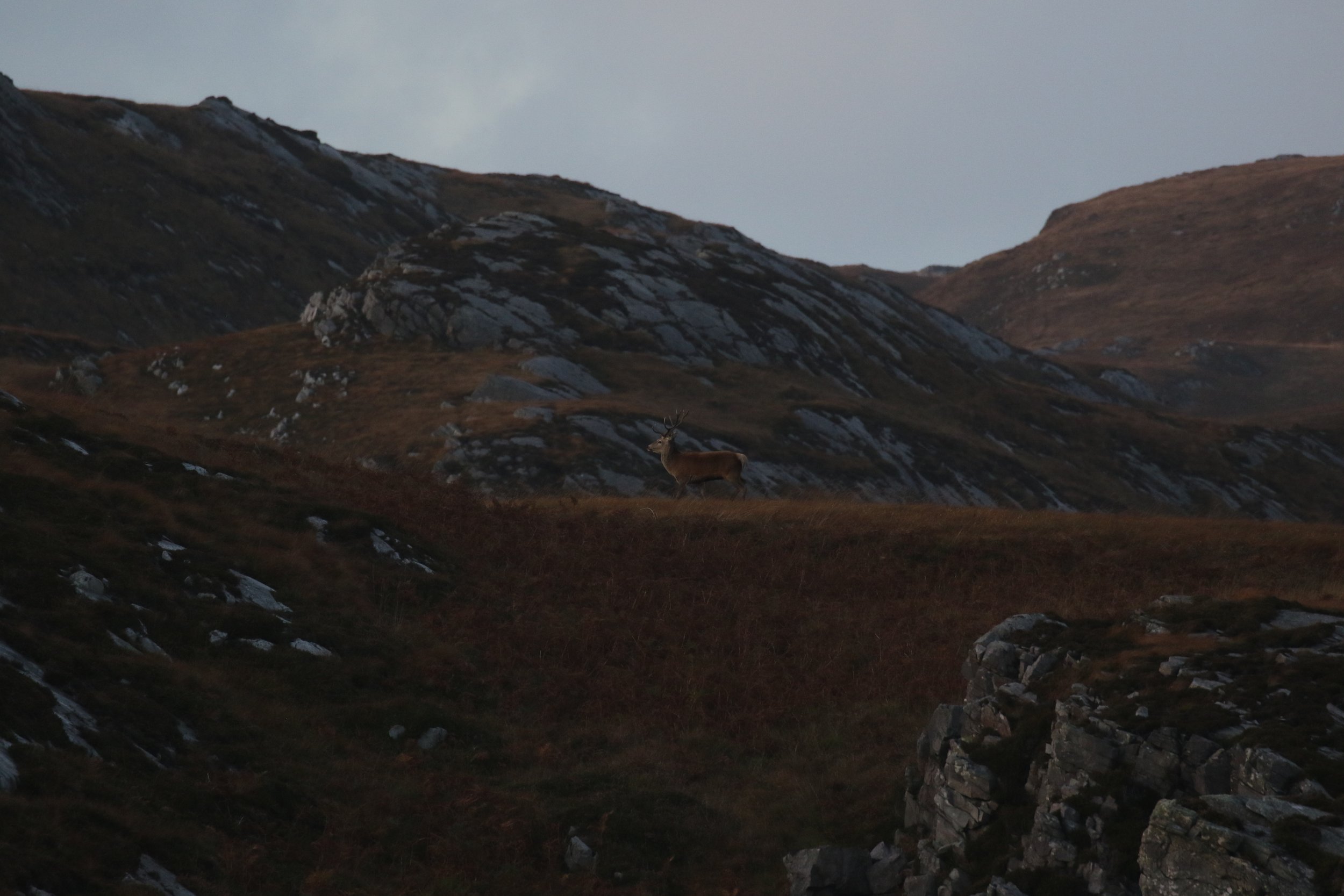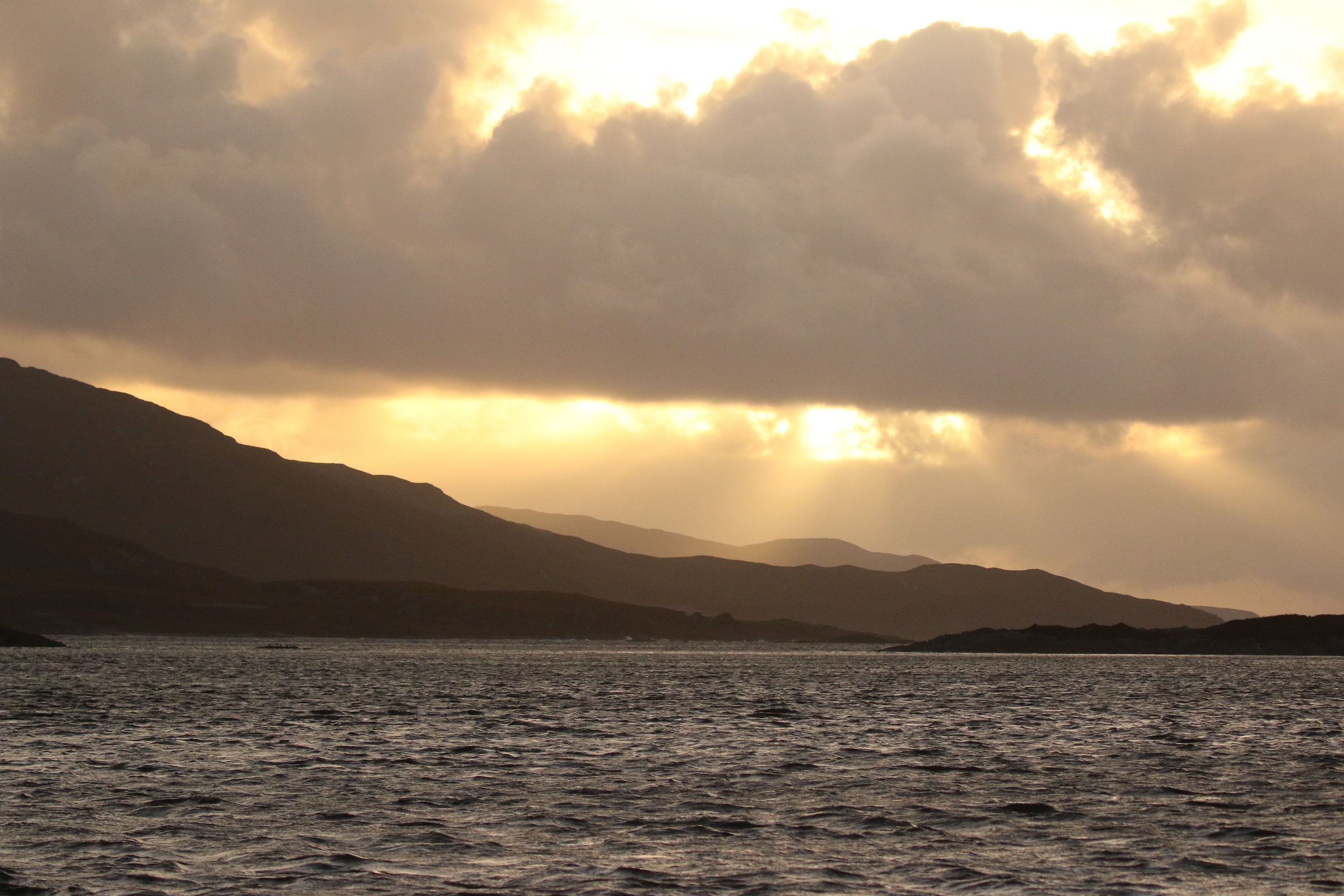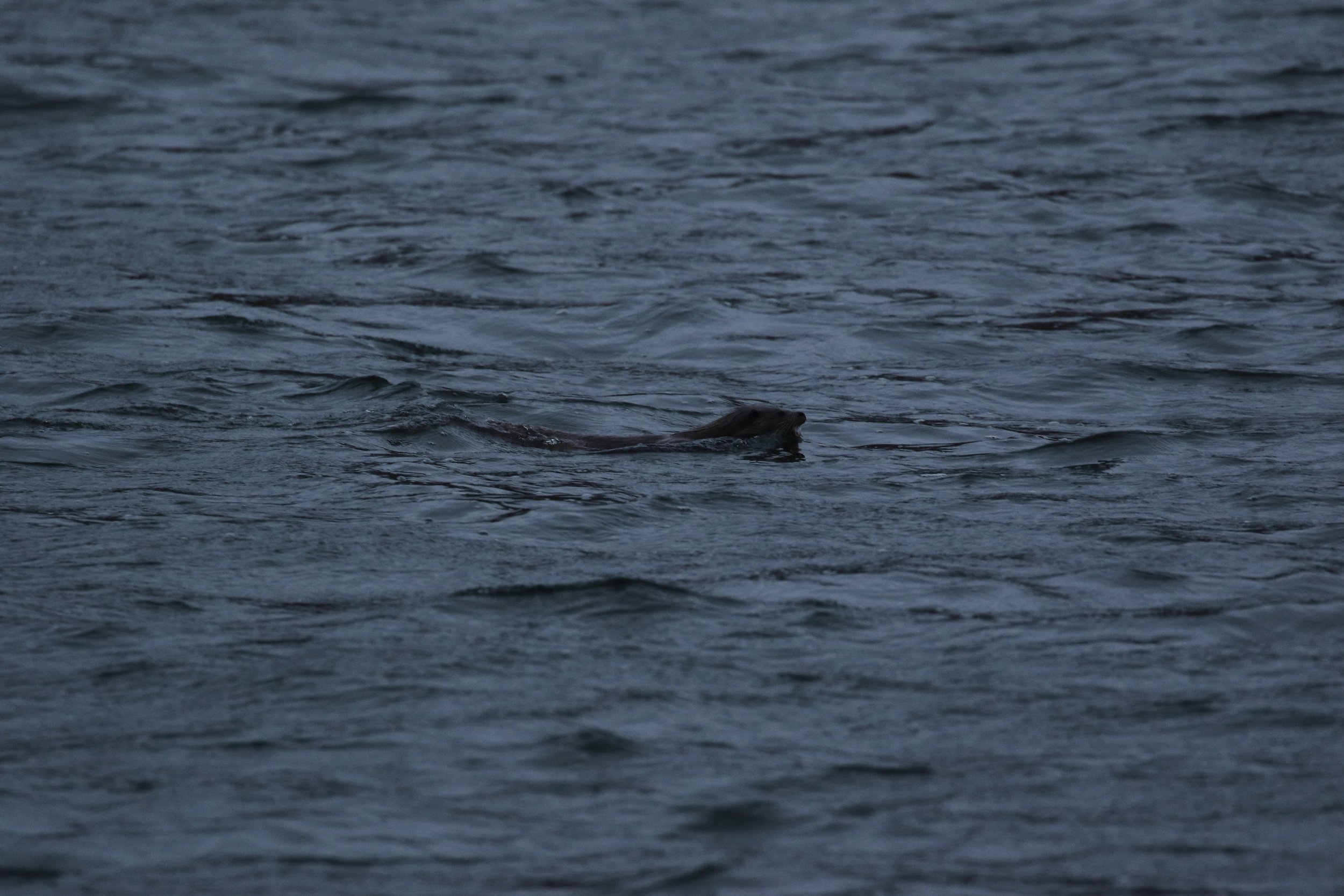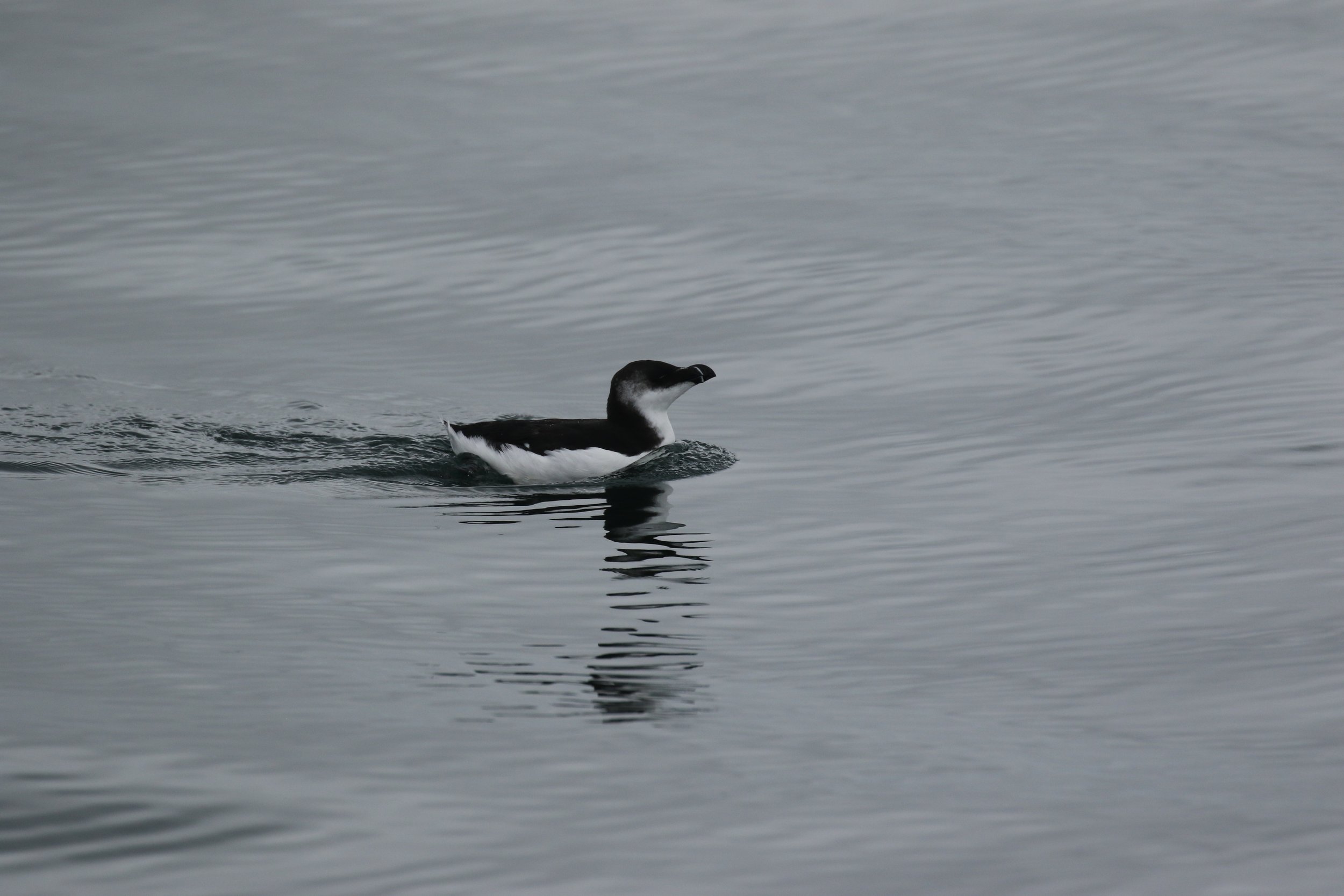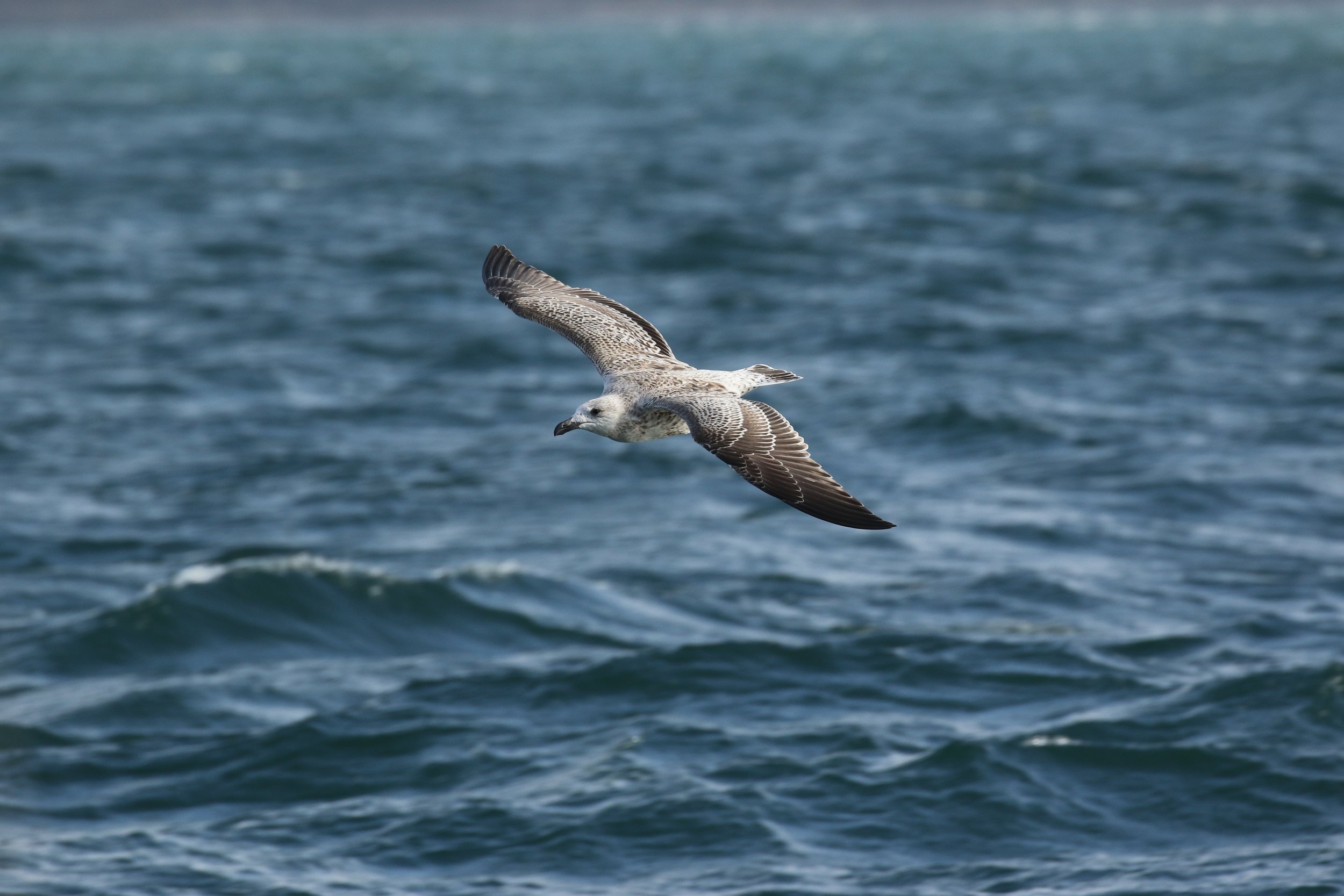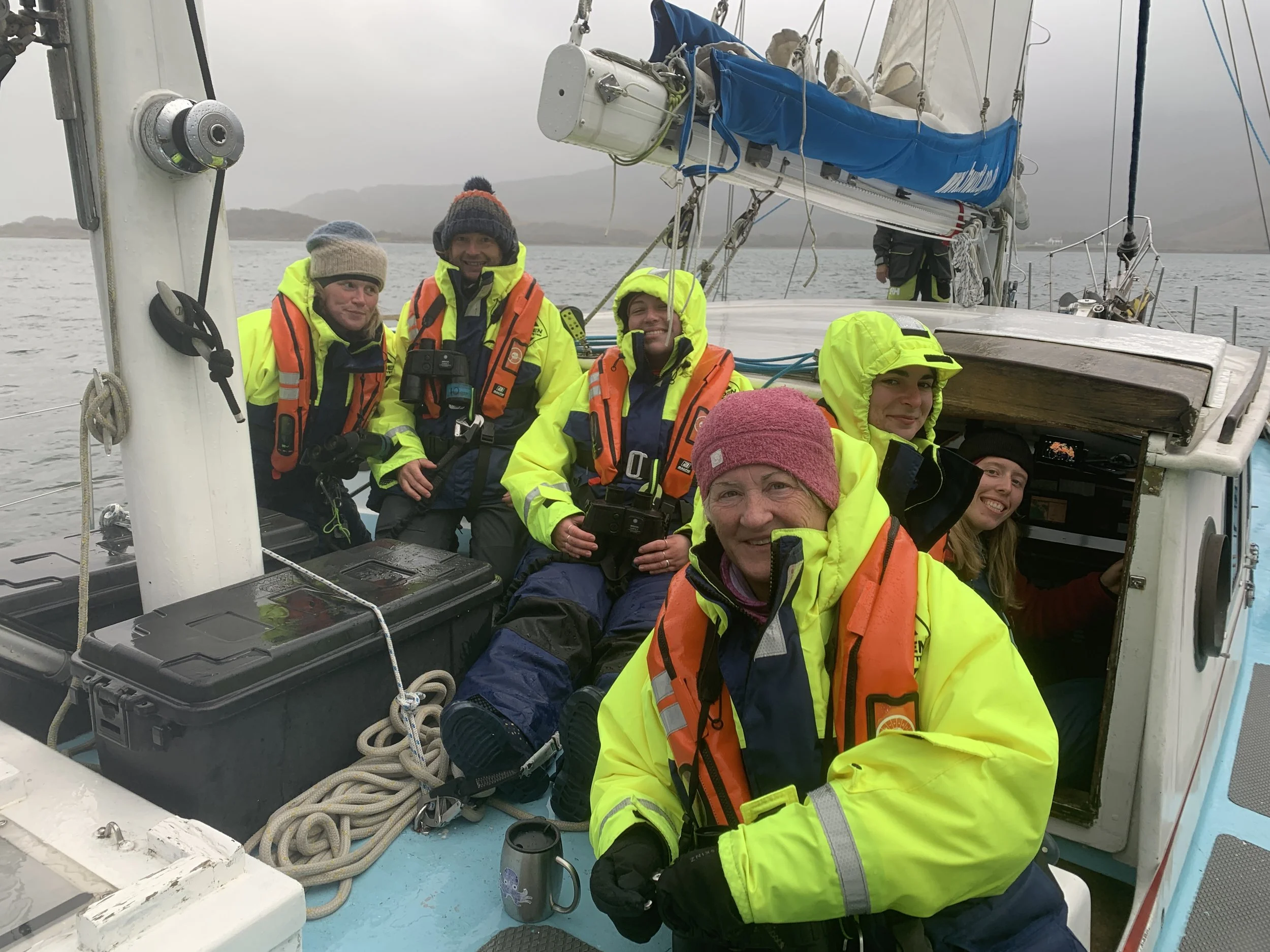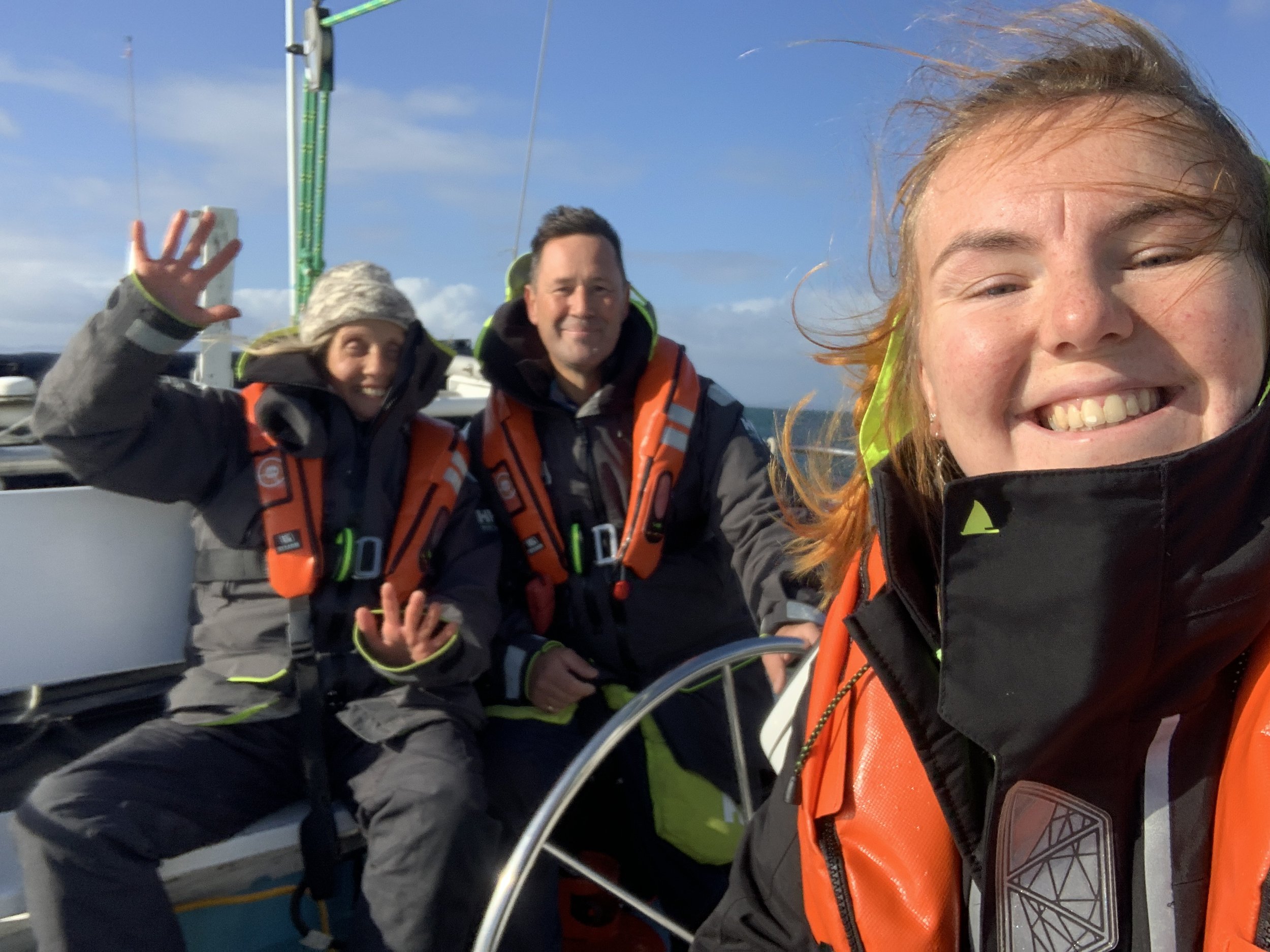Bottlenose dolphins bring delight to all those onboard during the sixteenth expedition of the season
OUR SIXTEENTH RESEARCH EXPEDITION OF 2022 LEFT TOBERMORY FOR A 12-DAY SURVEY MONITORING THE MARINE ENVIRONMENT OF THE HEBRIDES ONBOARD SILURIAN - OUR RESEARCH VESSEL. TRICKY WEATHER PERSISTED THROUGHOUT THE TRIP BUT OUR DETERMINED BUNCH OF VOLUNTEERS CONTINUED TO SURVEY IN ALL WEATHER CONDITIONS IN THE HOPE OF SEEING SOME MARINE MAMMALS. HERE HANNAH LIGHTLEY, SCIENCE OFFICER ON BOARD, RECALLS THE EXPEDITION…
Silurian welcomed Jayne, Luke, Franzi, Bettie, Vanessa, and Kate along with Crew Celia, Bruce, Hannah, and Abby aboard for the 16th trip of the season. After our first night in Tobermory, a last-minute change from Mallaig due to weather conditions, our first day started with a survey protocol presentation and safety briefings. Whilst on the foredeck we spotted our first sighting of the trip - a grey seal before even leaving the mooring.
Once all kitted up for the rain, we left Tobermory on our first survey effort. Sightings included lots of creels, a grey seal and Franzi spotting the first cetaceans of the trip - 3 harbour porpoises! Due to the high winds, we ventured into Loch Sunart for the afternoon surveying throughout the loch however due to the bad weather and reduced visibility we turned around early and headed into our anchorage for the evening at Loch na Droma Bruidhe.
After a wet and windy night, we started the day in Loch na Droma Bruidhe, and quickly made our way out into the Sound of Mull, with an eventual destination of Loch Linnhe. Coming out of Loch Sunart, we ventured upon a couple of grey seals to start the day. They looked at us and then having assessed the boat properly, promptly disappeared on their way. Within the Sound, Franzi and Vanessa had great spots of harbour porpoises, but dolphins and whales have eluded us. A great day for birders, we had our first spot of a storm petrel and many guillemots, kittiwakes, and gannets.
We passed the new ferry boat for Mull – the Loch Frisa - twice, and its larger cousin - the Isle of Mull – once. Alongside a few trawlers, these boats produced significant noise pollution whilst conducting acoustic listening surveys. The weather markedly improved as the day went on. Blue sky appeared on the periphery of the sky and the seas calmed to gentle wavelets for much of the day. This evening we have moored adjacent to Lismore in the hope of a sheltered evening, and soon have a shore visit to stretch our legs and climb the big hill around Port Ramsay.
The day started early at 4 am with the crew needing to move the boat as the wind direction changed increasing the bad weather. As we travelled along in the dark, Hannah made the most of the opportunity to carry out an acoustic survey at an unusual hour whilst the volunteers slept. Breakfast was had on route down the loch towards Tobermory until light allowed volunteers to go onto visual effort. Once on effort, within a minute, Betty spotted 3 harbour porpoises followed shortly after by another – quite possibly the quickest sighting in history! Several sightings were made heading down the Sound including further harbour porpoises, grey seals, and an unidentified seal. Birds were also in good form as we saw kittiwakes, guillemots, shag/cormorants and large gulls. As the sound of Mull is a busy vessel highway to the Hebrides, we heard several remote vessels on the hydrophone which obliterated any other sounds. We ended our day in the beautiful spot of Lochaline earlier than planned. An enjoyable walk was undertaken along the edge of the loch where we spotted a playful otter and several herons.
The afternoon ended with watching a talk on basking sharks from Dr Matt Witt from Exeter University where it was brilliant to hear that the data collected by HWDT was integral to supporting the introduction of a new marine protected area for basking sharks. The team put their skills to the test to make brilliant origami sharks, whales, creels, and boats to decorate Silurian and we all now feel like we’re under the water with those amazing creatures.
Expecting a ‘stormbound day’ we got a lie-in until 8.30 am this morning. However, we woke to good news – we could get out on the survey! We headed out of Lochaline after breakfast during a lull in the weather. The plan was to then up the sound of Mull towards Loch Spelve, battling some big weather to head towards the loch Vanessa and Franzi did an amazing shift on the mast in 1.5 swells with lots of spray to the face! Attempting to reach the entrance to Loch Spelve soon became too difficult so we turned around towards the shelter of the Sound of Mull with a new plan. Incredibly, we maintained visual and acoustic effort throughout! Unsurprisingly due to poor sighting conditions we had a very fleeting view of grey seals however a very friendly harbour porpoise came to say hello only a few metres from the boat. As the weather was closing in again, we headed back into anchor near Lismore. This evening Hannah is going to give an in-depth talk on cetacean acoustics and the acoustic survey protocol.
Another lie in this morning, as we were waiting for some of the tides to change to allow passage through Cuan Sound later in the afternoon. The day started with sunshine, but as soon as we went on effort a little downpour occurred. We won’t touch too much on the weather today, but largely it was sunshine for 10 minutes and downpour for 10 minutes on repeat. On the bright side, we had 10 rainbows, which everyone was very excited about!
Today brings our first day out of the Sound of Mull. Crossing the Sound did get a little swirly, and we all duly came off effort for about 45 minutes as we crossed the swells. Sadly, we saw no cetaceans through the waves, but two grey seals, two storm petrels and a surprise Golden Eagle were stars of the show today. We’re hoping for good weather tomorrow, but we won’t yet speak about Sunday, we hear the big winds are a comin’. Positive thoughts are all around for dolphin sightings tomorrow.
At last, there was a break in the weather, so we made a dash for the Sound of Jura. Whilst sitting in the saloon, Frazni spotted a big splash in the distance through the windows. This was our moment - ‘WITH WHALE’ was shouted and soon enough we headed towards the splashes to find a pod of bottlenose dolphins loitering! We moved slowly towards the pod and to our surprise and joy they came over to see us. They played off the bow and then came in under to bow-ride. Hannah and Abbie were on the cameras to get shots of their fins for photo identification, hopefully, we can look through these one evening to work out who came to say hello! After 30mins of sheer delight, we left the pod and everyone was delighted on board to finally (after days of manifestation) encounter some dolphins.
We continued south completing new transect lines that have not been covered this season, spotting harbour porpoise and an unidentified seal. Some of the volunteers got a chance of proper sailing, managing to put up to gib and down again (due to the changing squall). At 13.30 we turned around and returned north continuing our super straight transect lines at greater than 30-degree angle turns, creating lovely zigzags on the map. It was a day of many weather conditions (sun, rain, sun, drizzle, and sun again) but we have now arrived in ‘fake’ Tobermory (Craobh Haven Harbour) where our plan is to assess the local environment through Pub sampling.
We awoke to a very wet Craobh Haven Marnina but some got to enjoy a long hot shower ashore, with others not being so lucky with dodgy showers. Our stormbound day started with a talk by Emily Hague on the impacts of different vessel noises on marine mammals followed by attempting to match our bottlenose dolphin sightings from yesterday to those in the catalogue. This turned out to be a lot trickier than expected so we look forward to hearing from Dr Lauren if there has been a match! Our knowledge gained in the week was then put to the test in Hannah’s quiz, consisting of 3 rounds: HWDT, the Hebrides and music intros of sea-related songs. Turns out, not all lighthouses are named ‘George’ and have alternative names such as Skerryvore or Ardnamurchan and we should have paid more attention over the previous week.
Following this, we were on ‘free time however, given the weather it was not the most appealing to venture out. The majority decided to stay in and watch Moana, some decided to enjoy the showers again while a few ventured out into the wilds around the harbour. We had hoped the wind would ease by 4 pm so that we could get out on the seas again. However, the winds were still howling at 4 pm therefore, another lecture from the winter series was put on, this time by SMASS surrounding necropsies. Meanwhile, a few turned the many lemons on board into a cake! At 5 pm Celia announced the wind would stop and so it did! We set sail, undertaking just over 30mins on effort before anchoring for the evening in Loch Melfort. There was a beautiful sunset, along with a grey seal waiting to greet us. Once anchored we turned up the tunes and partied on deck and we’re now awaiting to find out what the delights of the ‘Silurian Olympics’ are.
The crew awoke early to take advantage of the tides and move the boat out of Loch Melfort. The volunteers went on effort around 8:30 am in the Sound of Jura, determined to spot something in the once again tricky conditions, Hannah spotted the first two sightings - both grey seals. After a few hours of being on effort we took temporary shelter in a bay off Jura with the winds being stronger than anticipated. After a screening of Frozen Planet II episode 3 (featuring Pandas and Pumas) and a look at the Silurian shop, Celia and Bruce got us underway to pass through the Sound of Islay.
We had great views of the many distilleries along the shore but sadly no further sightings. There were large swells particularly as we approached the entrance to our anchorage at Loch Tarbet but everyone continued to stay on effort throughout. Bruce completely unphased in the galley made a delicious hummus spread while the boat was rockin’ and rollin’. Another good day for bird spotting - plenty of gannets, swans, guillemots and razorbills today. As well as many rainbows including a full half-circle double rainbow! Our evening ended in the inner loch of Loch Tarbert, an amazing sail by Celia to our destination passing stags and goats along the shore.
We had sailed out from our protected mooring as the sun rose and anchored up again for breakfast. The day started well as we spotted two otters (one coming very close to the bow for Hannah to get a couple of pictures) and several grey seals, perhaps the same one, whilst having breakfast. Silurian set sail out of the sound and up past the west side of Jura with views of Colonsay and Oronosay. As we reached level with the Corryvreckan the swell and rock of the boat began to pick up, finally an enjoyable experience for all on board as we had finally gained our sea legs.
As we neared the Sound of Mull the bird numbers began to pick up - a hopeful sight for spotting some more marine mammals! We soon realised if we sang, the wildlife would surface to determine what horrific noise was occurring. Our Science Officer has now decided to publish a paper on the correlation between singing and sightings, as we spotted two grey seals and two harbour porpoise during our rendition of pop, children’s and Christmas songs whilst at the mast. We have moored up for the night near Craignure to enjoy haggis (veggie), neaps and tatties for our final evening onboard Silurian.
Of course, our final morning onboard Silurian was accompanied by wind and spray to the face but nevertheless, three grey seals and two harbour porpoise were spotted before returning to Tobermory Bay. The afternoon was spent cleaning the boat ready for the final trip of the season as well as having a potter around the shops. Tonight we are having a meal to celebrate all our hard work during this challenging survey and will hopefully spot a few rally cars in the car park!
Across the 12 days, the group surveyed 313 nautical miles of Hebridean waters encountering 4 different species of marine mammal.
A great big thank you to volunteers BETTIE, JAYNE, LUKE, VANESSA, KATE AND FRANZIE. YOUR EXTRA HARD WORK DURING THIS CHALLENGING SURVEY HAS CONTRIBUTED TOWARDS THE IMPORTANT CONSERVATION AND PROTECTION OF SCOTTISH MARINE MAMMALS.
Showing the track line of the area surveyed and sightings during HWDT 16.
THANKS ALSO TO NATURESCOT FOR SUPPORTING THE DATA COLLECTION ON BOARD SILURIAN.

